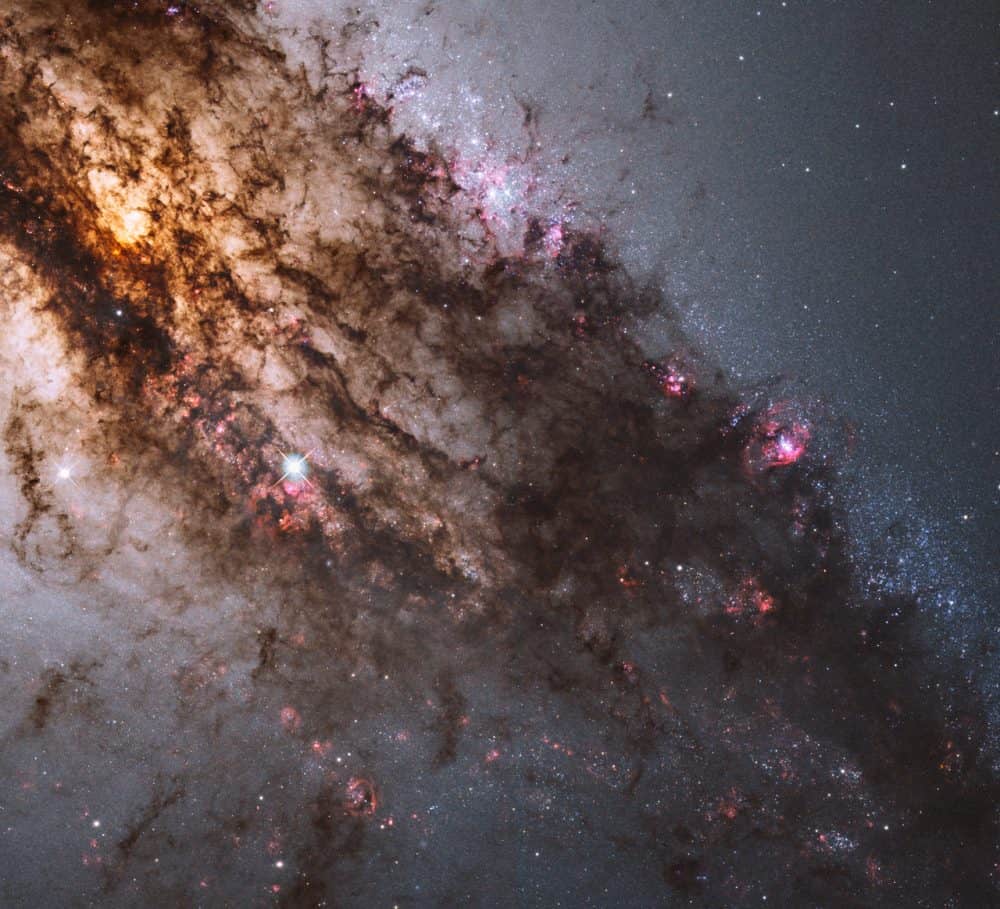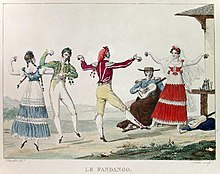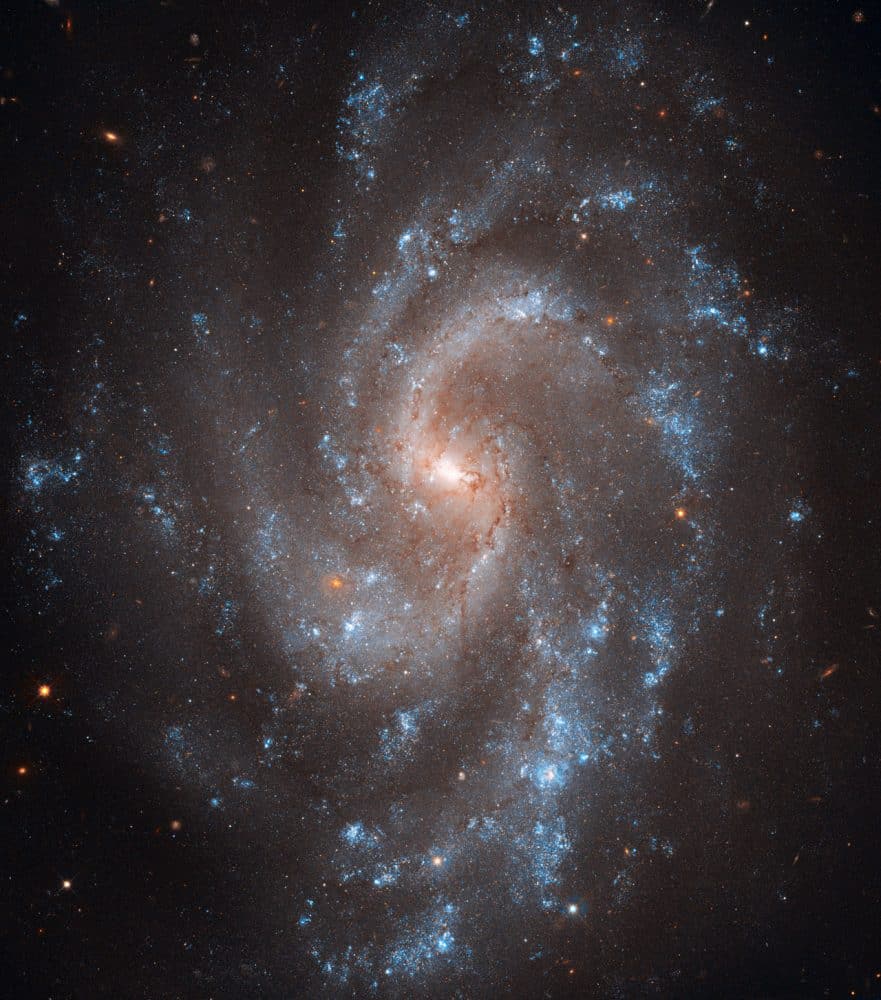Blog
Resembling looming rain clouds on a stormy day, dark lanes of dust crisscross the giant elliptical galaxy Centaurus A.
Hubble’s panchromatic vision, stretching from ultraviolet through near-infrared wavelengths, reveals the vibrant glow of young, blue star clusters and a glimpse into regions normally obscured by the dust.
The warped shape of Centaurus A’s disk of gas and dust is evidence for a past collision and merger with another galaxy. The resulting shockwaves cause hydrogen gas clouds to compress, triggering a firestorm of new star formation. These are visible in the red patches in this Hubble close-up.
At a distance of just over 11 million light-years, Centaurus A contains the closest active galactic nucleus to Earth. The center is home for a supermassive black hole that ejects jets of high-speed gas into space, but neither the supermassive black hole or the jets are visible in this image.
This image was taken in July 2010 with Hubble’s Wide Field Camera 3.
more...George M. Duke (January 12, 1946 – August 5, 2013) was an American keyboard pioneer, composer, singer-songwriter and record producer. He worked with numerous artists as arranger, music director, writer and co-writer, record producer and as a professor of music. He first made a name for himself with the album The Jean-Luc Ponty Experience with the George Duke Trio. He was known primarily for thirty-odd solo albums, of which A Brazilian Love Affair from 1980 was his most popular, as well as for his collaborations with other musicians, particularly Frank Zappa.
George Duke was born in San Rafael, California and raised in Marin City. At four years old he became interested in the piano. His mother took him to see Duke Ellington in concert and told him about this experience. “I don’t remember it too well, but my mother told me I went crazy. I ran around saying ‘Get me a piano, get me a piano!'” He began his formal piano studies at the age of 7 at a local Baptist church.
In 1975, Duke fused jazz with pop, funk, and soul music on his album From Me to You. Three years later his album Reach for It entered the pop charts, and his audiences increased. During the 1980s his career moved to a second phase as he spent much of his time as a record producer. He produced pop and R&B hits for A Taste of Honey, Jeffrey Osborne, and Deniece Williams. His clients included Anita Baker, Rachelle Ferrell, Everette Harp, Gladys Knight, Melissa Manchester, Barry Manilow, The Pointer Sisters, Smokey Robinson, and Take 6.
more...James Columbus “Jay” McShann (January 12, 1916 – December 7, 2006) was a jazz pianist and bandleader. He led bands in Kansas City, Missouri, that included Charlie Parker, Bernard Anderson, Ben Webster, and Walter Brown.
McShann was born in Muskogee, Oklahoma, and was nicknamed Hootie. Musically, his education came from Earl Hines‘s late-night broadcasts from Chicago’s Grand Terrace Cafe: “When ‘Fatha’ [Hines] went off the air, I went to bed”. He began working as a professional musician in 1931, performing around Tulsa, Oklahoma, and neighboring Arkansas.
McShann moved to Kansas City, Missouri, in 1936, and set up his own big band, which variously featured Charlie Parker (1937–42), Al Hibbler, Ben Webster, Paul Quinichette, Bernard Anderson, Gene Ramey, Jimmy Coe, Gus Johnson (1938–43), Harold “Doc” West, Earl Coleman,Walter Brown, and Jimmy Witherspoon, among others. His first recordings were all with Charlie Parker, the first as the Jay McShann Orchestra on August 9, 1940.
more...Fred McDowell (January 12, 1906 – July 3, 1972), known by his stage name Mississippi Fred McDowell, was an American hill country blues singer and guitar player.
McDowell was born in Rossville, Tennessee. His parents, who were farmers, died in his youth. He started playing guitar at the age of 14 and played at dances around Rossville. Wanting a change from plowing fields, he moved to Memphis in 1926, where he worked in the Buck-Eye feed mill, which processed cotton into oil and other products. He also had a number of other jobs and played music for tips. In 1928 he moved to Mississippi to pick cotton. He finally settled in Como, Mississippi, about 40 miles south of Memphis, in 1940 or 1941 (or maybe the late 1950s), and worked steadily as a farmer, continuing to perform music at dances and picnics. Initially he played slide guitar, using a pocketknife and then a slide made from a beef rib bone, later switching to a glass slide for its clearer sound. He played with the slide on his ring finger.
Although commonly regarded as a Delta blues singer, McDowell may be considered the first north hill country blues artist to achieve widespread recognition for his work. Musicians from the hill country – an area parallel to and east of the Delta region – produced a version of the blues somewhat closer in structure to its African roots. It often eschews chord change for the hypnotic effect of the droning single-chord vamp. McDowell’s records offer glimpses of the style’s origins, in the form of little-recorded supporting acts such as the string duo Bob and Miles Pratcher, the guitarist Eli Green, the fife player Napoleon Strickland, the harmonicist Johnny Woods and Hunter’s Chapel Singers. McDowell’s style (or at least its aesthetic) can be heard in the music of such hill country figures as Junior Kimbrough and R. L. Burnside, who in turn served as the impetus behind the creation of the Fat Possum record label in Oxford, Mississippi, in the 1990s.
more...Senegal/France
more...NGC 7814 (also known as UGC 8 or Caldwell 43) is a spiral galaxy about 40 million light-years away in the constellation Pegasus. The galaxy is seen edge-on from Earth. It is sometimes referred to as “the little sombrero”, a miniature version of Messier 104. The star field behind NGC 7814 is known for its density of faint, remote galaxies as can be seen in the image here – in the same vein as the Hubble Deep Field.
more...
Lee Mack Ritenour (born January 11, 1952) is an American guitarist who has been active since the late 1960s, playing numerous styles of jazz. He has been described as a “flawless” “musical chameleon” by AllMusic. Ritenour has won one Grammy Award with a sum of sixteen nominations.
Ritenour was born on January 11, 1952 in Los Angeles, California. At the age of eight he started playing guitar and four years later decided on a career in music. When he was 16 he played on his first recording session with the Mamas & the Papas. He developed a love for jazz and was influenced by guitarist Wes Montgomery. At the age of 17 he worked with Lena Horne and Tony Bennett. He studied classical guitar at the University of Southern California.
Ritenour’s solo career began with the album First Course (1976), a good example of the jazz-funk sound of the 1970s, followed by Captain Fingers, The Captain’s Journey (1978), and Feel the Night (1979).
In 1979, he “was brought in to beef up one of Pink Floyd’s The Wall ‘ heaviest rock numbers, “Run Like Hell“.[4] He played “uncredited rhythm guitar” on “One of My Turns“. As the 1980s began, Ritenour began to add stronger elements of pop to his music, beginning with Rit (1981). “Is It You” with vocals by Eric Tagg reached No. 15 on the Billboard pop chart and No. 27 on the Soul chart.[7] The track peaked at number fifteen on Hot Adult Contemporary chart. He continued with the pop-oriented music for Rit/2 (1982) and Banded Together (1984), while releasing a Direct-Disk instrumental album in 1983 called On the Line. He also provided rhythm guitar on Tom Browne‘s album Funkin’ for Jamaica. He recorded Harlequin (1985) with Dave Grusin and vocals by Ivan Lins. His next album, Earth Run, was nominated for a Grammy Award for Best Jazz Fusion Performance. The album’s title track was also Grammy nominated in the category of Best Instrumental Composition.[3][9] Portrait (GRP, 1987) included guest performances by The Yellowjackets, Djavan, and Kenny G.
more...
Calvin “Cal” Massey (January 11, 1928 – October 25, 1972) was an American jazz trumpeter and composer.
In the late 1950s he led an ensemble with Jimmy Garrison, McCoy Tyner, and Tootie Heath; John Coltrane and Donald Byrd occasionally played with them. In the 1950s he gradually receded from active performance and concentrated on composition; his works were recorded by Coltrane, Tyner, Freddie Hubbard, Jackie McLean, Lee Morgan, Philly Joe Jones, Horace Tapscott and Archie Shepp. Massey played and toured with Shepp from 1969 until 1972. He also performed in The Romas Orchestra with Romulus Franceschini.
Massey died from a heart attack at the age of 44 in New York City, New York. His son, Zane Massey (born 1957), is also a jazz musician.
more...James Isaac Moore (January 11, 1924 – January 31, 1970), better known by his stage name Slim Harpo, was an American blues musician, a leading exponent of the swamp bluesstyle, and “one of the most commercially successful blues artists of his day”. His most successful and influential recordings included “I’m a King Bee” (1957), “Rainin’ In My Heart” (1961), and “Baby Scratch My Back” (1966) which reached no. 1 on the R&B chart and no.16 on the US pop chart. A master of the blues harmonica, his stage name was derived from the popular nickname for that instrument, the “harp”.
Moore was born in Lobdell, Louisiana, the eldest child in his family. After his parents died he worked as a longshoreman and construction worker in New Orleans in the late 1930s and early 1940s. Influenced in style by Jimmy Reed, he began performing in Baton Rouge bars under the name Harmonica Slim, and also accompanied his brother-in-law Lightnin’ Slim in live performances.
He started his own recording career in March 1957, working with the A&R man and record producer J. D. “Jay” Miller in Crowley, Louisiana. At his wife’s suggestion, he took the name Slim Harpo in order to differentiate himself from another performer called Harmonica Slim. His first solo release, for Excello Records, based in Nashville, Tennessee, was “I’m a King Bee“, backed with “I Got Love If You Want It” in 1957. The other musicians on the recording were Gabriel “Guitar Gable” Perrodin (guitar), John “Fats” Perrodin (bass), and Clarence “Jockey” Etienne (drums). Harpo played guitar in his live shows, but he usually used other guitarists when recording. The record was a regional hit but failed to make the national charts.
more...World Music on Flamenco Fridays featuring Fandango.
Fandango is a lively couples dance from Spain, usually in triple metre, traditionally accompanied by guitars, castanets, or hand-clapping (“palmas” in Spanish). Fandango can both be sung and danced. Sung fandango is usually bipartite: it has an instrumental introduction followed by “variaciones”. Sung fandango usually follows the structure of “cante” that consist of four or five octosyllabic verses (coplas) or musical phrases (tercios). Occasionally, the first copla is repeated.
Eighteenth century Castilianfandango dancers (by Pierre Chasselat) (1753–1814)
Fandango rhythm.
The meter of fandango is similar to that of the bolero and seguidilla. It was originally notated in 6/8 time, but later in 3/8 or 3/4.
more...
https://www.youtube.com/watch?v=SDJSXHkd6z8
more...The plane of our Milky Way Galaxy runs through this complex and beautiful skyscape. Seen toward colorful stars near the northwestern edge of the constellation Vela (the Sails), the 16 degree wide, 200 frame mosaic is centered on the glowing filaments of the Vela Supernova Remnant, the expanding debris cloud from the death explosion of a massive star. Light from the supernova explosion that created the Vela remnant reached Earth about 11,000 years ago. In addition to the shocked filaments of glowing gas, the cosmic catastrophe also left behind an incredibly dense, rotating stellar core, the Vela Pulsar. Some 800 light-years distant, the Vela remnant is likely embedded in a larger and older supernova remnant, the Gum Nebula. Objects identified in this broad mosaic include emission and reflection nebulae, star clusters, and the remarkable Pencil Nebula.
more...Sir Roderick David Stewart, CBE (born 10 January 1945) is a British rock singer and songwriter. Born and raised in London, he is of Scottish and English ancestry. Stewart is one of the best-selling music artists of all time, having sold over 100 million records worldwide. He has had six consecutive number one albums in the UK and his tally of 62 UK hit singles includes 31 that reached the top ten, six of which gained the #1 position.Stewart has had 16 top ten singles in the US, with four reaching #1 on the Billboard Hot 100. He was knighted in the 2016 Birthday Honours for services to music and charity.
With his distinctive raspy singing voice, Stewart came to prominence in the late 1960s and the early 1970s with The Jeff Beck Group, and then with Faces, though his music career had begun in 1962 when he took up busking with a harmonica. In October 1963, he joined The Dimensions as a harmonica player and part-time vocalist. In 1964, Stewart joined Long John Baldry and the All Stars, and in August, Stewart signed a solo contract, releasing his first single, “Good Morning Little Schoolgirl“, in October. He maintained a solo career alongside a group career, releasing his debut solo album, An Old Raincoat Won’t Ever Let You Down in 1969. Stewart’s early albums were a fusion of rock, folk music, soul music, and R&B.
From the late 1970s through the 1990s, Stewart’s music often took on a new wave or soft rock/middle-of-the-road quality, and in the early 2000s, he released a series of successful albums interpreting the Great American Songbook. In 1994, Stewart staged the largest free rock concert in history when he performed in front of 3.5 million people in Rio de Janeiro. In 2008, Billboard magazine ranked him the 17th most successful artist on the “Billboard Hot 100 All-Time Top Artists”. A Grammy and Brit Award recipient, he was voted at #33 in Q Magazine‘s list of the Top 100 Greatest Singers of all time, and #59 on Rolling Stone 100 Greatest Singers of all time. As a solo artist, Stewart was inducted into the US Rock and Roll Hall of Fame in 1994, the UK Music Hall of Fame in 2006, and was inducted a second time into the US Rock and Roll Hall of Fame in 2012 as a member of Faces.
more...Mike Stern (born January 10, 1953) is a six-time Grammy-nominated American jazz guitarist. After playing with Blood, Sweat & Tears, he worked with drummer Billy Cobham, then with trumpeter Miles Davis from 1981 to 1983 and again in 1985. Following that, he began a solo career, releasing more than a dozen albums.
Stern was named Best Jazz Guitarist of 1993 by Guitar Player magazine. At the Festival International de Jazz de Montréal in June 2007, he was given the Miles Davis Award, which was created to recognize internationally acclaimed jazz artists whose work has contributed significantly to the renewal of the genre. In 2009 he was listed on Down Beat‘s list of 75 best jazz guitarist of all time. He was presented with Guitar Player magazine’s Certified Legend Award on January 21, 2012.
Mike Stern was born Michael Sedgwick in Boston, Massachusetts, the son of Helen (Burroughs) and Henry Dwight Sedgwick V.[1] His sister Holly is the mother of actor Philip Nozuka and singers George Nozuka, Justin Nozuka, and Henry Nozuka. Stern is married to guitarist and vocalist Leni Stern.
more...Maxwell Lemuel Roach (January 10, 1924 – August 16, 2007) was an American jazz drummer and composer. A pioneer of bebop, he worked in many other styles of music, and is generally considered alongside the most important drummers in history. He worked with many famous jazz musicians, including Coleman Hawkins, Dizzy Gillespie, Charlie Parker, Miles Davis, Duke Ellington, Thelonious Monk, Abbey Lincoln, Dinah Washington, Charles Mingus, Billy Eckstine, Stan Getz, Sonny Rollins, Eric Dolphy, and Booker Little. He was inducted into the DownBeat Hall of Fame in 1980 and the Modern Drummer Hall of Fame in 1992.
Roach also led his own groups, most notably a pioneering quintet co-led with trumpeter Clifford Brown and the percussion ensemble M’Boom. He made numerous musical statements relating to the civil rights movement.
Max Roach was born to Alphonse and Cressie Roach in the Township of Newland, Pasquotank County, North Carolina, which borders the southern edge of the Great Dismal Swamp. Many confuse the Township of Newland with Newland Town in Avery County, North Carolina. Although his birth certificate lists his date of birth as January 10, 1924, Roach has been quoted by Phil Schaap as having stated that his family believed he was actually born on January 8, 1925.
Roach’s family moved to the Bedford-Stuyvesant neighborhood of Brooklyn, New York when he was 4 years old. He grew up in a musical home, his mother being a gospel singer. He started to play bugle in parade orchestras at a young age. At the age of 10, he was already playing drums in some gospel bands.
In 1942, as an 18-year-old recently graduated from Boys High School, he was called to fill in for Sonny Greer with the Duke Ellington Orchestra when they were performing at the Paramount Theater in Manhattan. He starting going to the jazz clubs on 52nd Street and at 78th Street & Broadway for Georgie Jay’s Taproom, where he played with schoolmate Cecil Payne.[5] His first professional recording took place in December 1943, supporting Coleman Hawkins.
He was one of the first drummers, along with Kenny Clarke, to play in the bebop style. Roach performed in bands led by Dizzy Gillespie, Charlie Parker, Thelonious Monk, Coleman Hawkins, Bud Powell, and Miles Davis. He played on many of Parker’s most important records, including the Savoy Records November 1945 session, which marked a turning point in recorded jazz. His early brush work with Powell’s trio, especially at fast tempos, has been highly praised.
more...
Juluka was a trailblazing band based in Johannesburg, South Africa, led by Johnny Clegg and Sipho Mchunu.
more...NGC 5584 was first spotted as a faint glow in the constellation of Virgo by the great visual observer E. E. Barnard, back in 1881, using just a 12.5-cm telescope. But, by bringing the power of Hubble to bear, the galaxy can be resolved into thousands of separate stars. Some of these stars vary in brightness and are classified as Cepheids. These are brilliant pulsating stars with a remarkable property — once the time it takes a Cepheid to brighten and fade is known, then it is possible to find how bright it actually is. When this information is combined with a measurement of how bright the star appears it is easy to work out how far away the star actually lies. This method is the most accurate and effective way to measure the distances to most nearby galaxies.
This trick has now been used as part of a major new study of the expansion rate of the Universe, led by Adam Riess at the Space Telescope Science Institute in Baltimore. By studying many Cepheids in several galaxies the team has been able to refine our knowledge of this expansion rate, expressed as a number known as Hubble’s constant, to an accuracy of 3.3 percent.
In addition to many Cepheids NGC 5584 was also recently the site of a type Ia supernova. These dramatic explosions of white dwarf stars are used as reference beacons for mapping the expansion, and acceleration, of the more remote Universe so this galaxy is a very valuable link between the two distance scales.
more...Joan Chandos Baez (/baɪz/; born January 9, 1941 Staten Island, NY) is an American singer, songwriter, musician, and activist[3] whose contemporary folk music often includes songs of protest or social justice. Baez has performed publicly for over 60 years, releasing over 30 albums. Fluent in Spanish and English, she has also recorded songs in at least six other languages. Although regarded as a folk singer, her music has diversified since the counterculture era of the 1960s, and encompasses genres such as folk rock, pop, country and gospel music.
Although a songwriter herself, Baez generally interprets other composers’ work,having recorded songs by Bob Dylan, the Allman Brothers Band, the Beatles, Jackson Browne, Leonard Cohen, Woody Guthrie, Violeta Parra, The Rolling Stones, Pete Seeger, Paul Simon, Stevie Wonder and many others. On her past several albums, she has found success interpreting songs of more recent songwriters, including Ryan Adams, Josh Ritter, Steve Earle, Natalie Merchant and Joe Henry.
She began her recording career in 1960 and achieved immediate success. Her first three albums, Joan Baez, Joan Baez, Vol. 2, and Joan Baez in Concert all achieved gold record status.
Songs of acclaim include “Diamonds & Rust” and covers of Phil Ochs‘s “There but for Fortune” and The Band‘s “The Night They Drove Old Dixie Down“. She is also known for “Farewell, Angelina“, “Love Is Just a Four-Letter Word“, “Forever Young“, “Here’s to You“, “Joe Hill“, “Sweet Sir Galahad” and “We Shall Overcome“. She was one of the first major artists to record the songs of Bob Dylan in the early 1960s; Baez was already an internationally celebrated artist and did much to popularize his early songwriting efforts.Baez also performed fourteen songs at the 1969 Woodstock Festival and has displayed a lifelong commitment to political and social activism in the fields of nonviolence, civil rights, human rights and the environment.
more...



